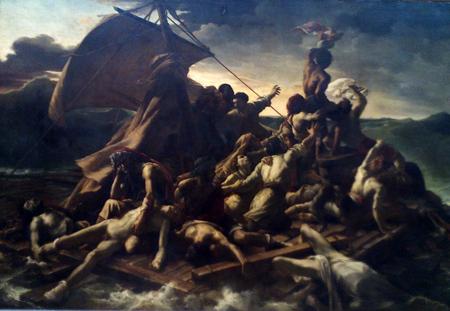During my recent visit to the Louvre, my wife drew my attention to a beautiful canvas by an author who was absolutely unknown to me: Géricault.
The canvas covered a whole wall in the middle of one of the huge rooms of the museum, in the section of French painters. The name of the work, Raft of Medusa, struck me and immediately I threw myself in search of the image of the Medusa, which often appears in works of art, but without any result. Medusa's head was not there!
At this point I ask for explanations to my wife who explains the story of the painting.
Medusa was the name of a French military ship carrying military and civilians, shipwrecked around the 1816. The painting represents the shipwrecked men who are crammed on a raft initially pulled by a lifeboat and are now drifting. Death and despair are well represented.
Upon returning home, intrigued, I looked for more information.
The ship Medusa, the flagship, commanded by the frigate captain Hugues Duroy de Chaumareys, sailed with the fleet in the 1816 direct in the reconquered French colony of Senegal. In the fleet there were soldiers and civilian settlers, including the future governor of Senegal with the family.
The fleet commander was not a great navigator expert and did not listen to his staff going to end up on a low ground off the coast of Africa.
The ship ran aground and despite the attempts made to free it, also due to a storm, it seemed to be on the verge of sinking so it was decided to abandon it.
The other ships in the fleet were distant as the flagship was faster and the commander had not traveled in formation.
Noble and wealthy were embarked on the boats, the rest of the staff on a raft built initially to lighten the ship in an attempt to unblock it.
The raft, with 152 on board among sailors, soldiers and civilians, was fixed to one of the boats but soon, it is not clear why, it ends adrift. There is not enough food for everyone on the raft and cohabitation is not the best. Lies and mutinies follow each other while trying to reach the coast without success. Several men are thrown into the sea and murders and incidents of cannibalism occur.
Thirteen days later, the ship Argus sent by the commander on the site of the shipwreck to recover gold and silver, finds the remains of the raft with fifteen survivors on board, five of these will die before docking at the port of Saint-Louis, Senegal.
This ugly page of French maritime history is represented with great realism by the author Théodore Géricault, decreeing his fortune.
Alessandro Rugolo












